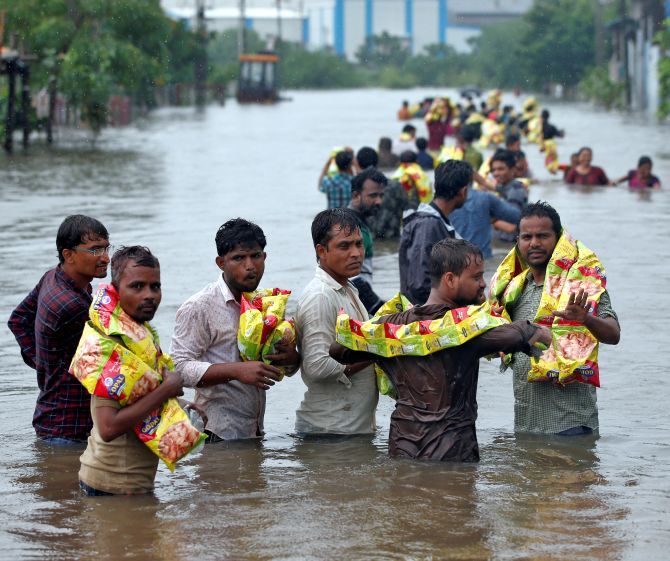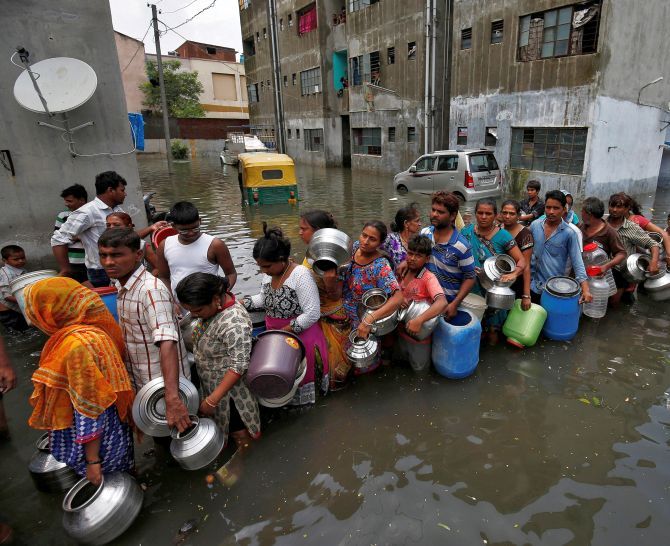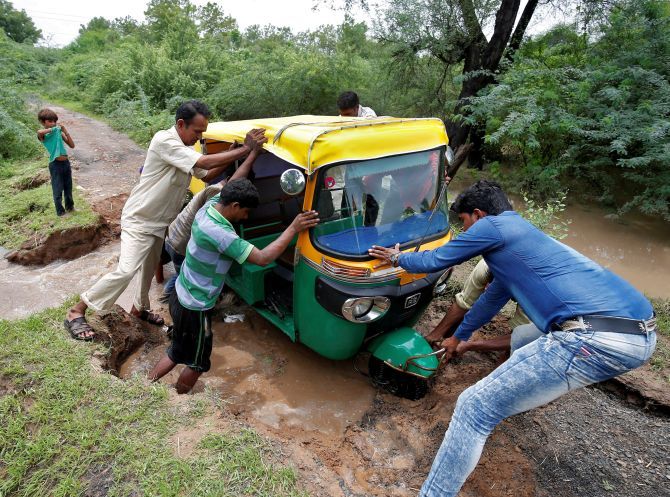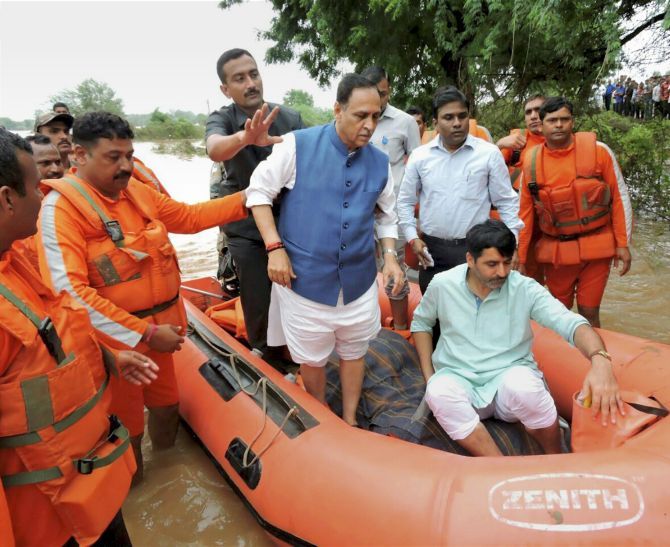Simultaneous activation of both Arabian Sea and Bay of Bengal low-pressure systems has led to the state receiving an excess 65 per cent rainfall.
Vinay Umarji reports.

With just days to go before the month ends, Ahmedabad may break a 112-year old record of highest rainfall in July it had set in 1905. Gujarat, especially in the northern and western parts, received good rainfall this year. Ahmedabad has already received 828.2 mm rains, as against a normal level of 291.1 mm.
At a time when nine districts of Assam saw 60,000 people being affected by floods, questions arose over Prime Minister Narendra Modi’s aerial review of the flood situation in Gujarat, especially in Banaskantha which faced maximum fury of rains this year. However, according to experts, unlike eastern states which face such situations almost in every monsoon due to the proximity to Bay of Bengal, the floods in Gujarat were unprecedented.

Photograph: Amit Dave/Reuters
Unlike historically when onset of monsoon caused either an active system emerging from Arabian Sea or Bay of Bengal lashing heavy rains, this year both the systems have been active and caused simultaneous low pressure over Gujarat. What further aggravated the scenario is the merger of these two active systems lasted for more days than usually seen in other cases of flooding such as in Assam this year or last year in Chennai.
“This is definitely one of the heaviest rainfall. Usually Gujarat gets rainfall either from Bay of Bengal or Arabian Sea. This year, both the systems are active simultaneously. In a typical normal monsoon, however, the system comes from Bay of Bengal,” said Jayant Sarkar, director of the Indian Meteorological Department, Ahmedabad.

Mahesh Palawat, vice president, meteorology and climate change, Skymet Weather Services said, “ Normally, Gujarat does not receive such torrential rains. It was way back in 1905 that Ahmedabad had received record highest rainfall of 952.5 mm in July. Since then, we haven’t seen such a downpour in July. This is due to low-pressure areas being developed over the system emerging from Bay of Bengal, which travelled across central India to reach Gujarat.”
“The other reason is this (rain) lasted for a longer duration and poured over several parts of the state unlike last year in Chennai where it was concentrated only on northern coastal areas of Tamil Nadu. Compared to Chennai last year and Assam this year, the rainfall has been heavy, prolonged and widespread across the state,” Palawat added.

The state has already seen over 55,000 being rescued, even as rain-related deaths were reported at over 110 so far across Gujarat. According to Nitin Patel, deputy chief minister at the Gujarat government, eight more teams of National Disaster Response Force are expected to join the rescue work apart from 10 existing teams, six Army columns and 11 State Disaster Response Force teams, among other agencies.
“Normally, states like Assam and Meghalaya receive good rains but their topography is such that the rainwater gradually flows down and waterlogging is, therefore, uncommon. Compared to these northeastern states, the rainfall so far in Gujarat has been much heavier. What worsened the situation is that the excess rainfall in southern Rajasthan, which was more than 700 mm for two consecutive days, flowed back to Gujarat,” Palawat stated.

As of July 26, around 38 dams and reservoirs of the total 203 were over 90 per cent full and carried a high alert, followed by 19 dams and reservoirs with warning being 80-90 per cent full and another 15 being 70-80 per cent full.
According to the IMD data, between July 1 and 28, Gujarat has seen an excess 65 per cent rainfall at 559.4 mm, as against the normal of 339.6 mm for the said period. Area-wise, the highest rainfall has been witnessed by Banaskantha, Patan, Gandhinagar, Morbi, Surendranagar, Mehsana and Sabarkantha at 267 per cent, 208 per cent, 189 per cent, 174 per cent, 172 per cent, 130 per cent and 115 per cent, respectively.
Meanwhile, both state and central government teams are set to begin assessment of loss to the state including crop loss once the downpour slows down and waters recede.











